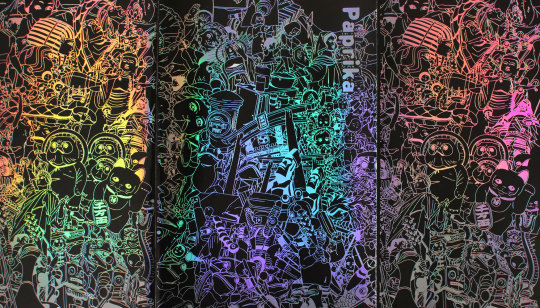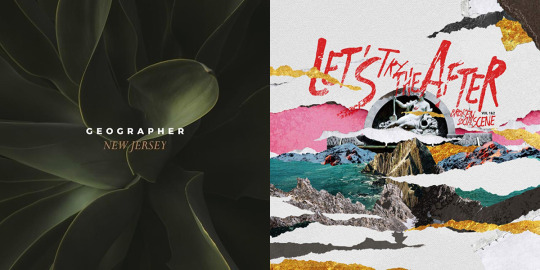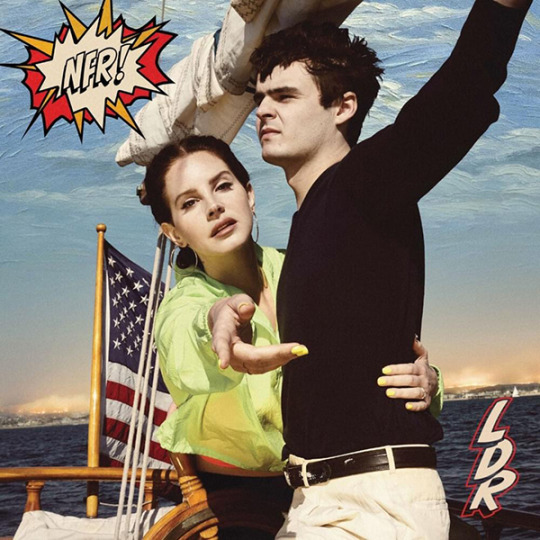#another in the post-Merge Nexus Force collection >:)
Explore tagged Tumblr posts
Text

Meiko Komori is a Bat Formling of the Never-Realm and member of the Paradox.
The young Meiko was raised in a very loving and charitable family, following on her grandmother's footsteps from whom she also inherited her name.
But the opportunity to help others wouldn't truly come until she was wounded following the chaos of the Merge. Treated by the kind Dr. Annete Liang, Meiko was more than inspired by the Nexus Force's efforts to selflessly help this new world be a better place, a new home for the misplaced. This is where she truly belonged, a path to help everyone.
Grandma Meiko would be proud.
#LEGO Universe#Our Universe#Meiko Komori#another in the post-Merge Nexus Force collection >:)#the quest to have as many LEGO species represented in the Force as possible continues
4 notes
·
View notes
Text
ESSAY: Globalization - Limits & Liminality as Explored in “Paprika”

Kon’s animated film Paprika, through symbolic and stylized means, serves as a critical frame for the phenomenon of globalization.
X-Posted at Pangaea Journal
Inspired by Yasutaka Tsutsui’s titular novel, Paprika begins much in the same fashion as it ends: in medias res, with a phantasmagorical montage of cultural iconography, quirky characters and surreal scenery interwoven at a frenzied pace, each scene jumping into the next with a fluidity that coalesces time and space itself into a distinctly Einsteinian continuum. Audiences are left dazed, disoriented, yet intrigued: there is no way to know whether the introductory sequence is chronicling a dream, or reality, or a freakish blend of both. This destabilizing visual narrative is fairly typical of Satoshi Kon’s craft, yet what calls for critical focus is the unique symbolism underpinning his work. Beneath its rich and densely-layered imagery, the film tackles a number of pertinent issues: from whether multimedia has warped from a benign platform into the jealous architect of our desires; to the tragic dissolution of individual ideas and complex cultures into a miasma of grotesque transnationalism; to whether the weakening friction-of-distance within a digitized world has brought us closer together, or merely distorted the very axes upon which time-space functions and is perceived. Indeed, at its crux, the film embraces a broad spectrum of issues uniquely linked to globalization, all while invoking relevant aspects of human fallacy and social degradation.
Central to Paprika, from the beginning, is its clear disdain for the linearity and two-dimensionalism of traditional narrative. Instead, like a hallucination, there appear to be no distinguishable boundaries between characters or places, no fixed destinations or rational coordinates. The most vivid example is the introductory sequence, where the eponymous protagonist, Paprika, leaps winsomely out of a man’s dreams and into the physical world: flitting from brightly-lit billboards as static eye-candy to a well-meaning sentry spying through computer screens to a godlike specter freezing busy traffic with a snap of her fingers to an ordinary girl chomping hamburgers at a diner to a stylized decal on a boy’s T-shirt to a motorcyclist careening through late-night streets (0:06:12-0:07:49).
Space and time are rendered meaningless – or, rather, are reshaped into something entirely novel and surreal. As Paprika navigates through a complex and dynamic mediascape, she effectively embodies the spilling-over of the virtual into the physical world – and, more significantly, of both the subtle and blatant permeation of media-based globalization in every step of our lives. Indeed, with its alternately fascinating and disturbing chaos of imagery, the very premise of Paprika blurs the boundaries between the inner and outer-worlds, conveying through both symbolic and subtextual allusions the phenomenon of globalization run riot – a dreamscape that unfolds with the benign promise of forging new connections, only to seep past the barriers of reality and engulf and reshape the world to the imperatives of dystopian homogeneity at best, and the subjugation and disintegration of individual autonomy at worst.
It can be argued, of course, that it is hypocritical for animation – in many ways the nexus of metamedia in its most intrinsically illusory form – to lambaste globalization. The media pivots on globalization in all its multifaceted vagaries, and vice versa. Renowned social theorist Marshall McLuhan, who coined the phrase ‘the global village’ in his groundbreaking work The Medium is the Message, was one of the first to point out that the form of a medium implants itself inextricably into whatever message it conveys in a synergistic relationship: “All media work us over completely. They are so pervasive in their personal, political, economic, aesthetic, psychological, moral, ethical, and social consequences that they leave no part of us untouched, unaffected, unaltered (26).” That the media and the phenomenon of globalization go hand-in-hand, shaping and influencing one another, therefore goes without saying. However, what the imagery of Paprika draws attention to is how the multiplicity of media leads to unpredictable consequences and vicissitudes – which are not always quantifiable or even tangible. Much in the same way technology and global interconnectivity have narrowed – at times even erased – the demarcations of time and space, so too have they led to paradigm shifts of what it means to belong to a static, physical place as a cultural and individual identifier.
Globalization is often defined as fundamentally kaleidoscopic, with a dizzying mobility of ideological, economic, physical and cultural interchanges across a rhizomatous network – but one that is increasingly powered by its own unstable energies and its own besieged and untidy logic. Of particular interest is the ‘disembodied’ component of globalization, where the flow of information and capital is increasingly encoded and abstract, and thus increasingly more likely to permeate local spaces that may not always be open to such profound transformation, imposition and redefinition. In their work, The Quantum Society, Zohar and Marshall liken the chaotic, fractal nature of the modern world to quantum reality, stating that it
…has the potential to be both particle-like and wave-like. Particles are individuals, located and measurable in space and time. Waves are ‘nonlocal,’ they are spread out across all of space and time, and their instantaneous effects are everywhere. Waves extend themselves in every direction at once, they overlap and combine with other waves to form new realities, new emergent wholes (326).
Unarguably, the focal point in Paprika is globalization as a catalyst of “new realities.” But while these can be captivating and edifying, allowing us to create or explore new identities, or to grow more closely tethered together, they can also represent the sinister infiltration of exploitative elements within our most intimate lives. This is made chillingly evident through the plot of the film, which centers on the theft of the DC Mini – a futuristic device that allows two people to share the same dream. While intended as a tool to help treat patients’ latent neuroses and deep-seated pathologies, the film makes clear that, if misused, this prototype can not only allow an intruder to access and influence another’s dreams, but can unleash the collective dream-world into the sphere of reality itself. The DC Mini, on its own, would function as a tepid metaphor for the symbiotic dance between globalization and technology. But following its theft, the resultant chaos it invokes sets the riveting, psychedelic stage upon which the inner-world of dreams erupts out into mundane reality, a fantastical convergence that not only threatens the safety of the entire city, but also denies each citizen their own private realm of dreams, within which they have the freedom to nurture a true inner-self. As Dr. Chiba – the no-nonsense alter-ego of our dreamscape superheroine Paprika – remarks: the victims of the abused DC Mini have become mere “empty shells, invaded by collective dreams… Every dream [the stolen DC Mini] came into contact with was eaten up into one huge delusion.” The scene is made particularly memorable by its vivid visual symbolism: two droplets of rainwater on a car window merging into one, highlighting the irresistible flow between not only dreams and reality, but the liminality of globalization as a fluid force that cannot be bound by temporal or spatial delineations (0:52:12-0:52:37).
It is precisely this unpredictable fluidity that runs rampant across real-life Tokyo in the film, wreaking havoc in its wake. Of particular interest is the gorgeous riot of imagery employed to represent the collective ‘delusion:’ the recurring motif of a parade, in all its clamorous splendor, that unfurls through the city streets, infusing spectators with its own peculiar brand of madness. For its eye-popping and mind-bending details alone, the sequence warrants close examination. But accompanying the visual feast is the nightmarish gamut of cultural, technological, social and historical commentary embedded within its imagery. To the cheerful proclamations of, “It’s showtime!” a procession of Japanese salarymen leap with suicidal serenity off of rooftops; below, the bodies of drunkenly-staggering bar-hoppers morph into unbalanced musical instruments, while families frolicking through the parade transform into rotund golden Maneki-neko to disturbing chants of, “The dreams will grow and grow! Let’s grow the tree that blooms money!” Here, in a scathing political lampoon, politicians wrestle one another in their eagerness to climb to the top of a parade-float; there, a row of schoolgirls in sailor uniforms, with cellphones for heads, lift their skirts for the eager gazes of equally cellphone-headed males.
Satoshi Kon does not bother with coy subtext; he announces the mind-degenerating effects of globalization on both dramatic and symbolic planes: a parade that swells into disorder and eventual destruction, headed by a clutter of sentient refrigerators, televisions, microwave ovens, vacuum cleaners, deck tapes and automobiles. Traditional Japanese kitsch competes with lurid Americana; cultural symbols like Godzilla and the Statue of Liberty waltz alongside such religious icons as the Virgin Mary, Vishnu and the Buddha, while disembodied torii arches and airplanes soar overhead to the discordant serenade of money toads and durama dolls. The effect is at once hypnotic and horrific; the vortex of collective dreams lures in countless spellbound bystanders, transforming them into just another mindless facet of the parade, from a robot to a toy to a centerpiece on a parade-palanquin. Witnessing the furor, one character dazedly asks, “Am I still dreaming?” and is informed, “Yes. The whole world is” (1:11:09-1:12:42)
In her book, Girlhood and the Plastic Image, Heather Warren-Crow remarks that Paprika “…proffers a visual theory of media convergence as not only an issue of technology, but also one of globalization… [Its] vision of media convergence is one in which boundaries between cultures, technologies, commodities and people are horrifyingly permeable… While our supergirl is eventually able to stop the parade… these multiple transgressions cause mass confusion, madness, injury and death (83).” If this seems a dark denouncement of globalization, one cannot deny that it is in many respects fitting. With the vanishing delineations between nations, cultures, ideas and people arises the phenomenon of “cultural odorlessness,” or mukokuseki. The term was first applied to rapid social transformations in Koichi Iwabuchi’s book Recentering Globalization: Popular Culture and Japanese Transnationalism, although the phenomena can just as readily be applied to postmodernity in all its miscellaneous facets (28). While globalization has engendered new intimacies and easier connections (on the surface), this overwhelming grid of interconnected information has simultaneously become a web trapping human beings inside it. Individuality – on a national, local, or personal scale – has been pushed aside in favor of a real and virtual superhighway powered by pitiless self-commodification and voracious consumership, within which the cultivation of a true self no longer holds meaning. One particular scene in the film captures this with wistful succinctness. As a weary Dr. Chiba gazes out of the window of her office, her livelier alter-ego Paprika (real or imagined) appears superimposed before her reflection. “You look tired,” Paprika says, “Want me to look in on your dreams?” to which Chiba replies, “I haven’t been seeing any of my own lately.” Against Paprika’s winsome overtones, her own demeanor strikes a chord that is dismal in its flatness. Although Chiba’s profession is to dive through the colorful welter of others’ dreams, it is her grasp of her own self that proves the ultimate fatality in this venture (0:24:10-0:24:23).
Indeed, it has often been argued that as both the physical and disembodied aspects of globalization grow increasingly more pervasive, so too do diverse organs of surveillance – from institutionalized dogmas meant to restrict personal development by branding it as outdated or subversive, to internal and external disciplinary structures meant to monitor and subjugate a person’s ‘inner-self:’ the very stuff of his or her dreams. Such themes, while hardly novel, are nonetheless relevant, tethered as they are to such iconic works as George Orwell’s Nineteen Eighty-Four, and Michel Foucault’s Discipline and Punish, both of which – through literal and metaphorical means – examine societies wherein people are subject to relentless government scrutiny, mind-policing and the absolute denial and denigration of privacy. Foucault’s work, in particular, is useful for deconstructing social mechanisms. Utilizing a genealogical historical lens, Foucault traces the slow and oppressive transformation – as opposed to ‘evolution’, a phrase often touted by proponents of liberal reform – of the Western penal system. His main focus is to illustrate how, despite our self-congratulatory complacence at moving away from the barbaric model of medieval punishment, in favor of gentler and more civilized modes of discipline, we have in fact simply transferred the imperatives of controlling human beings – be they deviants or conformists – from their bodies to their souls. As Foucault states, “Physical pain, the pain of the body itself, is no longer the constituent element of the penalty. From being an art of unbearable sensations punishment has become an economy of suspended rights,” thus intimating that the organs of institutional control have not grown less harsh or restrictive, but simply less overt (11).
Certainly, by relying on a framework of internal rather than external constraints, it has become possible to erode the very modicum of individuality, reducing human beings to what Foucault describes as “docile” bodies complicit in their own exploitation. Foucault lays the blame for this phenomenon on a capitalist system whose economic and political trajectory has led society to a place of commodification and classification (“governmentality”), where the complexities of dynamic individuals are pared down into reductionist categories of ‘acceptable’ or ‘unacceptable.’ According to Foucault, surveillance and regimentation as a means of producing compliant individuals is the crux of modern economies, to the point where society has transformed into an industrial panopticon – a nightmarish perversion of Jeremy Bentham’s original ideal. As such, whether individuals live as offenders within a prison, or as free citizens, is irrelevant. The scant difference in both their constraints is measured by mere degrees (102-128).
In Paprika, these issues are not explicitly announced, but are instead woven through the story’s fabric in an alternately lulling and disquieting fashion. Noteworthy scenes – such as where Paprika, a captive chimera with butterfly-wings, is pinned to a table while a man literally peels away her skin to paw rapaciously at the prone body of Dr. Chiba, nestled pupae-like within, to the moment where Detective Toshimi Konakawa, harried by recurring nightmares, bittersweetly comes to terms with boyhood dreams he had suppressed in order to survive by the dictum of a cold and prescriptive adult world – are all reminders that it is our inviolate inner-space that makes us uniquely human. To allow it to be invaded, subjugated and erased is to reduce ourselves to passive automatons, our every desire governed, our every choice predetermined. In Paprika, this knowledge blossoms only when each character delves deep into themselves, to find at their core the dream-child that remains untouched by reality’s smothering hold, and to discover within that dream-child both untapped softness and strength. “She’s become true to herself, hasn’t she?” Paprika playfully remarks of the somber Dr. Chiba, when the latter finally comes to terms with her repressed affection for the bumbling genius Tokita (1:15:42).
For Paprika, it is evident that social or technological transformations cannot be powered by the erosion of individual dreams. To do so is to condemn the world to an eldritch darkness sustained only by greed. The film’s penultimate scene, where the egomaniacal chairman – the true thief of the DC Mini – looms as a monstrous giant over the despoiled city, proclaiming, “I am perfect! I can control dreams and even death!” could almost serve as the critical foreshadowing of globalization taken to its bleakest conclusion: the desecration of nature and humanity alike by a self-serving force that, in its thirst for absolute control, will cancel out the very diversity of dreams that once made globalization possible. It is only when Paprika – fusing with Dr. Chiba and Tokita – reemerges in the form of a baby to battle the chairman, is equilibrium restored. “Light and dark. Reality and dreams. Life and death. Man and woman. Then you add the missing spice [Paprika],” she recites, as if listing ingredients to a recipe (1:19:50-1:20:32). Yet, in keeping with theme of liminality and indeterminacy, the key to vanquishing the chairman is not in these binary oppositions, but in their capacity to combine together and shape the world into more than one thing at once. As Paprika swallows the chairman whole, reversing the shadowy post-apocalyptic city to its original state, battle-scarred but still intact, the audience is reminded of fluidity of the quantum world. Life and death, dreams and reality, destruction and rebirth, all coalesce within an ever-transforming continuum.
So too, as the film’s open-ended yet distinctly uplifting ending makes clear, is the process of globalization inherently free-flowing and malleable in its interaction with its environment. Rather than focusing on the split between globalization as a force of cultural erasure versus a celebration of differences, the film highlights the alternately delicate or brutal negotiations between the two: a friction that is necessary to keep the phenomenon in flux. Zygmunt Bauman’s book and selfsame concept of Liquid Modernity proves especially useful here, in that in order to comprehend the mutable nature of the modern world, it is necessary to look beyond traditional models and regimented perceptions. As he makes clear:
Ours is … an individualized, privatized version of modernity, with the burden of pattern-weaving and the responsibility for failure falling primarily on the individual’s shoulders… The patterns of dependency and interaction … are now malleable… but like all fluids they do not keep their shape for long. Shaping them is easier than keeping them in shape. Solids are cast once and for all. Keeping fluids in shape requires a lot of attention, constant vigilance and perpetual effort – and even then the success of the effort is anything but a foregone conclusion (8).
Of course, the exchange of images and ideas across a would-be deterritorialized realm does not mean that the myriad components within must lose their separate identities. Rather, those identities become more essential than ever, bringing with them their own consequences and questions – all of which must be understood through the dynamic lens of globalization, until we come to understand not only the frailties of the social order, but how they can improved, in order to make connections both genuine and mutually-beneficial for a polyphonic future. The answers lie not within the inherently-shifting structure of globalization, but rather in its creative use. In the film’s final segment, where Detective Toshimi Konakawa purchases tickets to the movie, Dreaming Kids, after decades of stultifying self-repression, speaks of the capacity of globalized multitudes to enthuse as well as to ensnare the individual’s dreams. Globalization does not exist in a vacuum; even as it threatens to engulf nations, localities and persons into a bilious swamp of depersonalized shells, so too can it be transformed by the nature of the worlds it encounters. The change is double-edged and double-sided; the effect is a living, breathing bricolage that grows and alters as we do – and how we do.
That said, it is evident that Satoshi Kon’s message is not one of a facile globalized utopia. Rather, it is about the dangers of losing ourselves within such a seductive phenomenon, whose effects can too easily be maneuvered toward mass surveillance and subjugation. For Paprika, the cross-flow of cultures, ideas, commodities and people is illustrated as an unceasing process, but one that we ourselves are responsible for shaping. If done right, there is the tantalizing promise of a happier, freer life, within which globalization may enhance rather than exploit our dreams. But if done wrong, Kon’s narrative is bleakly apocalyptic – a world fallen victim to a hostile and all-pervasive force that gnaws away its very humanity. While the film’s content-driven, as opposed to structural, formula can be mystifying and overly-abstract at times, there is no denying its visual ingenuity: a multimedia extravaganza that beautifully translates the welter of dreams into reality. With its alternately fascinating and disturbing chaos of imagery, Paprika blurs the boundaries between the inner and outer-worlds, conveying through symbolic and subtextual allusions the phenomenon of globalization run riot – a dreamscape that yields both brighter possibilities and special connections if we do not allow it to diminish us, yet also a sinister agency of mass domination and dystopian homogeneity if we fail to put it in its proper place.
Works Cited
Bauman, Zygmunt. Liquid Modernity. Cambridge, UK, Polity Press, 2015.
Foucault, Michel. Discipline and Punish: The Birth of the Prison. New York, NY, Random House LLC, 1977.
Iwabuchi, Koichi. Recentering Globalization: Popular Culture and Japanese Transnationalism. Durham, Duke University Press, 2007.
Kon, Satoshi, director. Paprika. Madhouse Studios, 2006.
MacLuhan, Marshall. The Medium is the Message. Corte Madera, Gingko Pr., 2005.
Warren-Crow, Heather. Girlhood and the Plastic Image. Lebanon, University Press of New England, 2014.
Zohar, Danah, and I. N. Marshall. The Quantum Society: Mind, Physics and a New Social Vision. New York, Morrow, 1994.
1 note
·
View note
Text
Music I Liked in 2019
Every year I reflect on the pop culture I enjoyed and put it in some sort of order.
2019 was a great year for music, at least among the pop-leaning alt and indie rock I enjoy. Several favorite bands came back and knocked their latest efforts out of the park and I gained new appreciation for some artists that I’d never really connected with before. In fact, there was so much good music this year, I stretched my self-imposed Top 15 to get a few more records in. Of the three lists I write up each year, music is easily the most subjective because there’s a lot more of it out there and it’s even more fragmented, so I definitely don’t make any claims that these are the best albums of the year; they’re just my favorites and come highly recommended.
15. Better Oblivion Community Center – Better Oblivion Community Center

Phoebe Bridgers and Conner Oberst teamed up for this surprise release which merges both of their styles. The record is more electric/grungy than Bridgers’ solo output and though I’m not a big Oberst fan, there is still much to like here, especially the lovely ode to musical discovery “Chesapeake.”
14. Native Tongue – Switchfoot

Switchfoot have established a pattern of alternating records I adore (Hello Hurricane, Fading West) with records that do almost nothing for me (Vice Verses, Where The Light Shines Through). Native Tongue swings back to the positive column with a mix of shiny anthems and contemplative balladry. Maybe the next one will break the cycle and stay in the “win” column?
13. New Jersey EP – Geographer / Let’s Try the After EPs – Broken Social Scene

The digital-age trend of artists dropping EPs rather than full-lengths continued in earnest this year with a lot of decent short-form offerings. Geographer’s New Jersey EP is my favorite thing he’s done in years and Broken Social Scene’s two Let’s Try The After releases continue the revitalized kick begun with 2017’s Hug of Thunder.
12. (I Am) Origami Pt. 3 – A Catacomb Hymn – John Van Deusen

Former Lonely Forest frontman Van Deusen released the third in a series of solo records last year, this one reconciling the alt-rock angst of Pt. 1 and the spiritual introspection of Pt. 2. There’s a lot to dig into here, but I’m especially fond of “Fly Away to Hell,” an appeal to finding hope through the natural world’s beauty in the midst of despair.
11. Without Fear – Dermot Kennedy

Kennedy’s first full-length record comes on the heels of a series of EPs and includes several tracks cherry-picked from those yet still coheres as a whole. Mixing singer-songwriter guitar folk with modern pop production (including vocal distortion effects and massive percussion) yields a sound that is simultaneously raw and polished – and immediate. Highlights include “All My Friends,” “Moments Passed,” “Lost” and “Dancing Under Red Skies.”
10. Everyday Life – Coldplay / Hyperspace – Beck

The latest albums from these two alt-rock luminaries were released on the same day and both have a lot to recommend them, even if they don’t quite reach the heights of the artists’ best work. Everyday Life is an interesting grab bag of ideas that doesn’t quite gel, but it is far better than anything on the prior A Head Full of Dreams. Tracks like the quietly pretty “Èkó,” the Owl John-interpolating “Champion of the World” and the Afrobeat breakdown “Arabesque” are peak Coldplay. Hyperspace is Beck doing vaporwave, a mostly chill dive into existentialism that finds a medium between the neon pop of Colors and the mellow beauty of Morning Phase.
9. Rattlesnake – The Strumbellas

While even Mumford & Sons have tired of the banjo-rock trend they re-popularized, there are still some terrific folk-leaning bands keeping the tradition alive. The most recent record from the Strumbellas is a collection of upbeat anthems that celebrate life and hope with an honest tinge of existentialism. This is perfectly encapsulated on closer “All My Life,” an ode to the paradoxical nature of love (whether divine or romantic) as both heart-breaking and life-giving force.
8. I Am Easy to Find – The National

I Am Easy to Find is the National at their more gorgeously languid. With the inclusion of a chorus of female vocalists (one of three in a trend on this list), the music here expands in new directions. As a sister piece to a short film by artist/designer Mike Mills (Beginners), this record has the feel of a curated museum piece – in the best possible way. “Not in Kansas” references my favorite R.E.M. album, “Where Is Her Head” is all propulsive stream-of-consciousness, and the closing sequence from “Hairpin Turns” through “Light Years” is as strong as anything else in the band’s catalog. (If you like this record, I strongly recommend “Think You Can Wait,” their earlier collaboration with Sharon Van Etten for the soundtrack to Win Win.)
7. Surviving – Jimmy Eat World

2016’s Integrity Blues marked a return to form for Jimmy Eat World after a couple uneven efforts and Surviving sets the bar even higher. Zach Lind’s percussion comes through as clearly and strongly as the robust guitar riffs, making this one of the best rock records of the year. The album’s middle stretch – from the synthy staccato of “555” to the quiet-loud dynamism of “One Mil” to the Futures-esque “All The Way (Stay)” to the soaring immediacy of “Diamond” – may be my favorite 4-song sequence of any album this year.
6. In the Morse Code of Break Lights – The New Pornographers

Another dose of shimmering power-pop from the Canadian collective, In the Morse Code of Break Lights finds A.C. Newman at his most lyrically direct, confronting the current political landscape with comparisons to fallen empires of antiquity on the likes of “Colossus of Rhodes” & “One Kind of Solomon.” Standouts include those tracks as well as the rhythmic pulse of “Falling Down the Stairs of Your Smile” & “Opening Ceremony” and Simi Stone’s dynamic violin flourishes on “Dreamlike And On The Rush” & “Leather On The Seat.
5. Norman Fucking Rockwell! – Lana Del Rey

I’ve been on the fence about Lana Del Rey to this point, appreciating some of the singles I’ve heard but never fully engaging with her brand of arch romanticism. Whether her casually profane and resigned lyrics are authentically her or an ironic persona, NFR! is undeniable, reflecting the fatalism of young adulthood in Trump’s America with excellent songcraft. Jack Antonoff’s production floats her dreamy vocals over spare but lush instrumentation, creating a hazy atmosphere of malaise with maybe some glimmers of hope flickering through.
4. My Finest Work Yet – Andrew Bird

Another reflection of the times from an artist I’ve never quite connected with before, Bird’s wryly titled My Finest Work Yet focuses his droll wit on deconstructing American exceptionalism and imperialism. The wordplay throughout this record is ingenious, but it’s the compositions that really sell everything, with hooks a-plenty and warm jazz orchestration to counterbalance the heavy subject matter. And yes, there is some whistling.
3. NINE – blink-182 / Strange Love EP – Simple Creatures

If 2016’s California was preoccupied with recapturing the bratty pop-punk rush of Enema of the State, then NINE is blink-182’s return to the more experimental emo leanings of their self-titled 2003 release. While not quite as adventurous as that record, it’s definitely their best work since, featuring introspective lyrics, plenty of Whoa-Oh-Oh sing-a-longs and full integration of newest member Matt Skiba (who is deployed as much more than a Tom DeLonge surrogate this time out). Personal favorites include “Heaven,” “I Really Wish I Hated You,” “No Heart To Speak Of” and “Hungover You,” but this is a solid front-to-back listen.
2019 also saw Mark Hoppus team up with All Time Low’s Alex Gaskarth for two EPs under the moniker Simple Creatures. Strange Love is the stronger of the two and leans into synthpop territory with bright choruses, providing a nice complement to NINE.
2. Father of the Bride – Vampire Weekend

Aside from the stellar ��Harmony Hall,” the pre-release singles from Vampire Weekend’s latest didn’t really wow me and I worried that this record (the first without Rostam Batmanglij as a full member) would end their unimpeachable run. However, in the context of the album, everything works brilliantly, a clear case of the whole being greater than the sum of its parts. Ezra Koenig is at both his most experimental (see “Sympathy” and “Flower Moon”) and most traditional (see “Unbearably White” and “We Belong Together”) here, to great effect. Danielle Haim contributes vocals to several songs (two of three of the trend), tying everything together and adding a new dimension to the sound, which is still recognizably VW while expanding in new directions.
1. American Football (LP3) – American Football

Though I missed American Football’s initial late-90s run, I was glad to catch up with the band upon the release of their 2016 reunion album. Their music lives somewhere at the nexus of emo, post-rock, shoegaze and jazz, with instrumental motifs that call to mind Jimmy Eat World’s Clarity opus “Goodbye Sky Harbor.” 2019 brought a third LP (fortunately without a 17-year wait) that I believe is their best yet. Featuring female vocalists on several tracks (three of three of the trend), this set of songs has more immediate hooks without sacrificing lush guitar cascades or meditative polyrhythms. A perfect record to get lost in on a quiet morning drive – or any other time, really.
You know what’s better than reading about music? Listening to it. Here’s a sampling of songs from each of these records if you want an easily-digestible mix:
Bonus! Reinterpretation Albums:
Reworked – Snow Patrol – For Snow Patrol’s 25th year, they put out this album of new recordings of some of their greatest hits (and a few new songs for good measure). These reinterpretations aren’t drastically different from the originals, but they share a consistent coffeehouse vibe that makes for nice Sunday morning listening and a fresh approach to a typical “Best Of” record (which, to be fair, they have done before).
Tiny Changes: A Celebration of Frightened Rabbit’s ‘The Midnight Organ Fight’ – Various Artists – One of the final projects Scott Hutchison was involved with before his death, Tiny Changes bucks the trend of reissuing a landmark album on its anniversary. Instead, to commemorate 10 years of their breakthrough release, Frightened Rabbit tapped some of their favorite artists and friends (including the likes of Ben Gibbard, Manchester Orchestra and Julien Baker) to record cover versions of the whole thing. While nothing can touch the raw emotion of the originals, these interpretations reveal new dimensions to many of the songs, especially Daughter’s hauntingly beautiful and gut-wrenching take on “Poke.”
0 notes